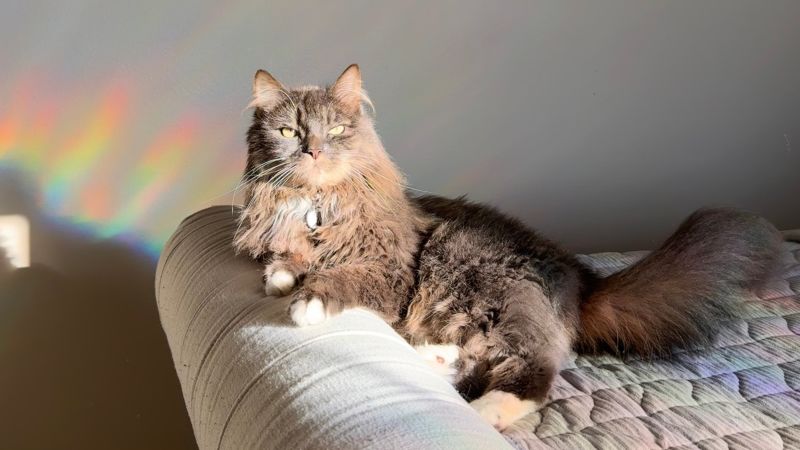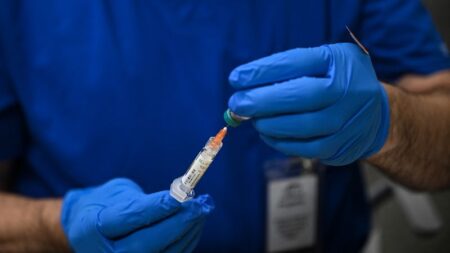Once upon a time in the suburbs of Portland, Oregon, a woman named Jamila Acfalle embarked on a unique journey to add a furry companion to her life. Unlike the traditional search for an adorable pet, Jamila had one particular requirement: the cat had to be brave. As a dog trainer who specialized in assisting canines with behavioral issues, she frequently brought these dogs into her home, making it crucial for her feline friend to be equipped to handle their exuberance.
In 2021, her quest led her to a litter of long-haired Maine Coon kittens. Among them, a smoke gray kitten captured her heart. This kitten confidently approached Jamila and sat at her feet, instantly solidifying the bond between them. “I knew at that moment that she was my cat,” Acfalle recounted in an interview. In a twist of irony given her dog Hero, she named her new cat Villain. The playful nickname reflected her beliefs: Villain quickly demonstrated a friendly, silly nature while adeptly keeping the dominating dogs in their place.
Beyond her affection for Villain, Jamila was diligent about her pet’s health, particularly in nutrition. Aligned with a growing trend among pet owners in the United States, she embraced the idea of feeding Villain a raw food diet. She asserted that raw meals were less processed than the conventional dry kibble and closely mirrored what cats might consume in the wild. However, this preference for raw food over the traditionally processed diets soon evolved into a controversial topic of discussion.
The appeal of raw diets for both humans and pets surged as a response to rising skepticism about heavily processed foods laden with chemical additives. Yet, experts in infectious diseases raised alarms about this growing inclination. They noted that raw food diverges from essential safety practices, such as heating dairy or cooking meats, which are vital to eradicate viruses and bacteria, particularly concerning the ongoing threat of bird flu.
On the cusp of winter, the U.S. Food and Drug Administration (FDA) revealed a disconcerting surveillance report: a spike in H5N1 incidents among domesticated and wild cats, with many cases linked to contaminated pet foods. Although canines could also become infected, they typically exhibited milder symptoms; cats bore a far graver risk. The guidance for pet owners began to echo through official channels, urging caution regarding uncooked pet foods and recommending stricter safety measures for food manufacturers, including cooking animal products.
Amid these occurrences, Jamila scrutinized various brands to determine which provided the safest options for Villain. She opted for frozen raw food nuggets, which she believed were packed with meat, organs, and bones. Villain thrived on this diet until suddenly, her health deteriorated. Following Thanksgiving, the once-active cat exhibited troubling behaviors: refusal to eat, bathroom issues, and signs of disorientation. Despite numerous pleas for her to eat, Villain seemed trapped in a cycle of panic, pacing relentlessly.
Tragically, soon after, Villain succumbed to a mysterious illness that left Jamila in disbelief and despair. Despite her efforts to seek veterinary assistance, Villain’s condition escalated too far, culminating in her passing in Jamila’s arms. In utter shock, Jamila elected to pursue a necropsy at Oregon State University to ascertain the cause of death.
What followed was heart-wrenching. The diagnosis revealed that Villain had contracted H5N1, directly linked to a batch of Northwest Naturals raw pet food that Jamila had regularly fed her pets. The implications were stark and left her grappling with feelings of guilt for having chosen this raw lifestyle for her beloved feline.
The broader conversations surrounding raw food gained momentum among pet owners. As more instances of H5N1 surfaced, particularly in cats, concerns intensified over the safety of raw diets. High-traffic grocery and pet food stores began to showcase aisles dedicated to raw pet foods—a market projected to explode from $3.7 billion to approximately $6.4 billion by 2028. But experts cautioned against the allure, emphasizing the risks and lack of nutritional advantage of raw feeding, especially given the prevalence of viruses like H5N1.
Experts like Dr. J. Scott Weese highlighted that cats are often less likely to receive adequate veterinary care, leading to a hidden prevalence of illness until it’s potentially too late. Concerns surged as two California residents, after recently losing beloved pets, investigated the possible connections between their cats’ illnesses and the tainted raw foods.
As ongoing investigations into raw food safety continued, both Jamila Acfalle and others were left navigating the aftermath of their choices while seeking answers and resolution from involved companies. Their narratives underscore a growing trend toward raw feeding amidst potential hazards, with many pet owners caught in a precarious balancing act between health ideals and safety risks.












